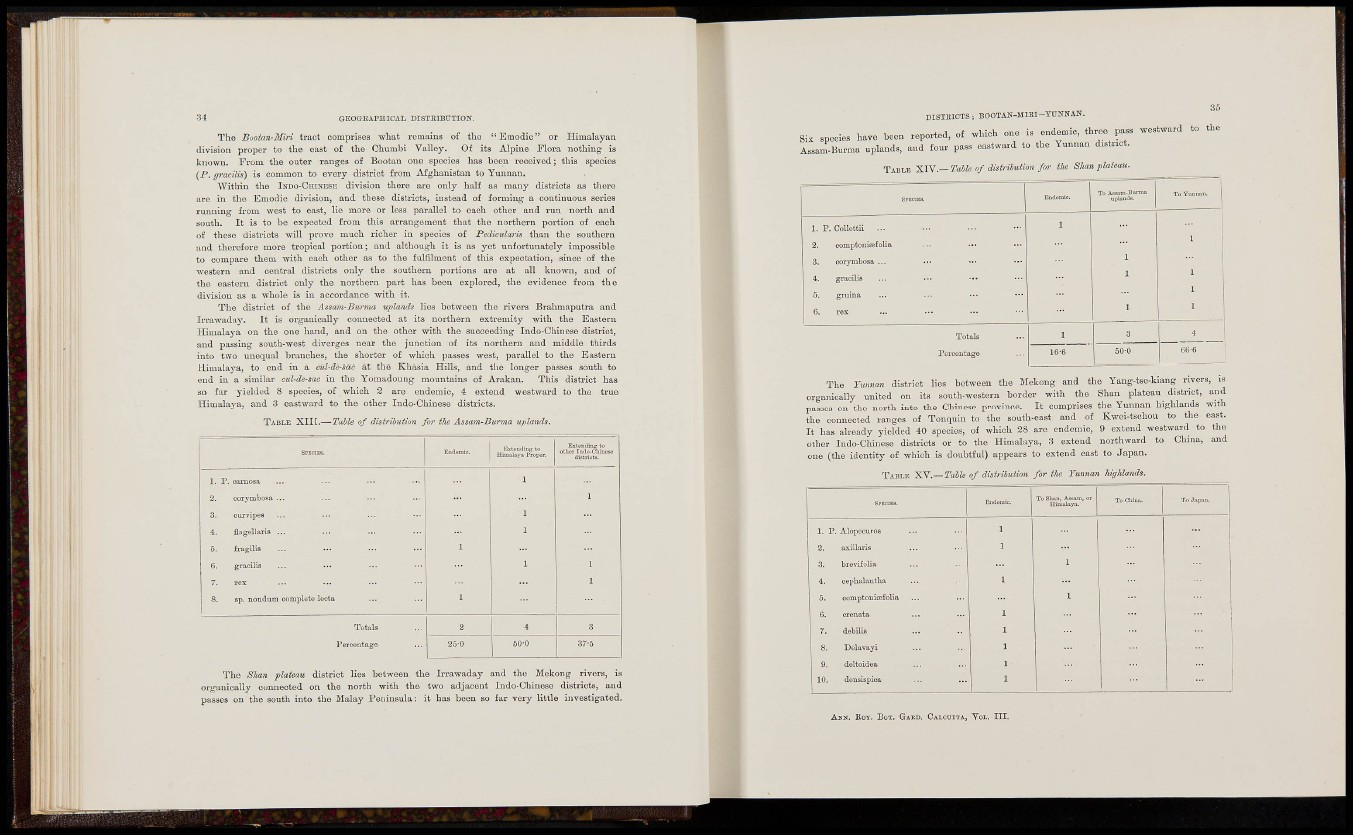
34 GEOGEAPHICAL DISTRIBUTION.
The Buotan-Miri tract comprises what remaias of tlio "Etuodic" or Himalayan
division proper to the east of the Chumbi Valley. Of its Alpine Flora nothing is
known. From the outer ranges of Bootan one species has been received; this species
(P. gracilis) is common to every district from Afghanistan to Yunnau.
Witlrin the INDO-CHINESE division there are only half as many districts as tiiere
are in the Emodic division, and these districts, instead of forming a continuous series
running fi-om west to east, lie more or less parallel to each other and run north and
south. It is to be expected from this arrangement that the northern portion of each
of these districts will prove much richer in species of Pedicularis than the southern
and therefore more tropical portion; and although it is as yet unfortunately impossible
to compare them with each other as to the fulfilment of this expectation, since of the
western and central districts only the southern portions are at all known, and of
the eastern district only the northern part has been explored, the evidence from the
di\'ision as a whole is in accordance with it.
The district of the Assam-Burma uplands lies between the rivers Brahmaputra and
Irrawaday. It is organically connected at its northern extremity with the Eastern
Himalaya on the one hand, and on the other with the succeeding Indo-Chinese district,
and passing south-west diverges near the junction of its northern and middle thirds
into two unequal branches, the shorter of which passes west, parallel to the Eastern
Himalaya, to end in a eul-de-sac at the Khasia Hills, and the longer passes south to
eud in a similar cul-de-sac in the Yotnadoung mountains of Arakan. This district has
so far yielded 8 species, of which 2 are endemic, 4 extend westward to the true
Himalaya, and 3 eastward to the other Indo-Chinese districts.
TABLE XIII.—Table of distribution for the Assam-Burma uplands.
1. p. carnosa
2. corymtosa ...
3. curvipes
4. fiagellaris ...
5. fragilÌB
6. gracilis
7. r . i
8. sp. nondum oom; plete lecta
othEerst «Innddo!n-Ogh tinoe sc districts.
The Shan plateau district lies between the Irrawaday and the Mekong rivers,
organically connected on the north with the two adjacent Indo-Chinese districts, and
passes on the south into the Malay Peninsula: it has been so far very little f
DISTRICTS; BOOTAN-MIRI-TTINNAN.
S;. species have been reported, of .Inch one is endecic, three pass westward to the
Burma uplands, and ionv pass eastward to the Yunnan district.
TiBLB XlY.— TaHeof dUrilution for tk SJan pMmu.
1. P. Collettii
2. comptonijefolia
3. corymbosa ...
4. gracilis
5. gruina
Totals
Percentage
The Tumm district lies between the Hekong and the Yang-tse-kiang rivers, is
organically united on its sonth-western border with the Shan plateau district, and
patses on the north into the Chinese province. It comprises the Yunnan highlands with
the connected ranges of Tonqnin to the south-east and of Kwei-tschou to the east.
It has already yielded 40 species, of which 28 are endemic, 9 extend westward to the
other Indo-Chinese districts or to the Himalaya, 3 extend northward to China, and
one (the identity of wliich is doubtful) appears to extend east to Japan.
TABLE XY.—Table of distrilmtim for the Tutmcm highlands.
Sl'EClBS. Endemic. To Shnn, Assam, or
Hinmlaya. ToOhintw
1. p. Alopecuros 1
2. axillaris 1
3. brevifolia 1
4. ceplialautlia 1
5. oomptoniceiolia 1
6. crenata 1
7. debilia 1
8. Delavayi 1
9. deltoidea 1
10. densispica
ANJJ. KOY. EOT. GARD, CALCUTTA, YOL. III.